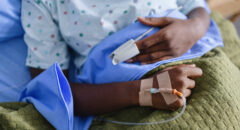
It's a life-and-death prediction: How likely is early-stage breast cancer to spread throughout the rest of a patient's body?
A new analysis that tried to make that call easier for doctors to predict found that a younger age at diagnosis was a strong indicator of spreading ("metastatic") cancer.
To come to that conclusion, the researchers analyzed data from tens of thousands of women who took part in more than 400 studies in North and South America, Europe, Africa, Asia and Oceania.
RELATED: 4 Early Signs That Cancer Is Spreading
What is the likelihood that breast cancer will spread?
For most patients, the risk of localized breast cancer spreading to other parts of the body was between 6% and 22%.
However, the risk was about 13% to 38% among women first diagnosed before age 35, while the risk was about 4% to 29% among women aged 50 or older, according to the study presented online at the Advanced Breast Cancer Sixth International Consensus Conference.
"This may be because younger women have a more aggressive form of breast cancer or because they are being diagnosed at a later stage," says lead researcher Eileen Morgan, from the International Agency for Research on Cancer.
Her team also found that women with luminal B cancer (which tends to grow faster) had a 4% to 35.5% risk of metastasis, while there was a 2% to nearly 12% risk in women with luminal A cancer (which tends to grow slower).
Not surprisingly, women with larger tumors at diagnosis had a higher risk of metastasis than those with smaller tumors.
Research presented at meetings should be considered preliminary until published in a peer-reviewed journal.
About 2.3 million people worldwide are diagnosed with breast cancer each year. Black women are disproportionately affected by more aggressive subtypes of breast cancer. This is the first study to examine how many of these patients developed advanced breast cancer, the researchers said in a meeting news release.
"Breast cancer is the most common form of cancer in the world. Most women are diagnosed when their cancer is confined to the breast or has only spread to nearby tissue," Morgan says.
"But in some women, the cancer will grow and spread to other parts of the body or come back in a different part of the body several years after the end of their initial treatment," she notes. "At this point, the cancer becomes much harder to treat and the risk of dying is higher. However, we don't really know how many people develop metastatic breast cancer because cancer registries have not been routinely collecting this data."
The analysis also suggested that rates of metastasis are lower in patients with more recent initial diagnoses than in those first diagnosed in the 1970s and 1980s.
However, some of the decrease may be due to the time lag between a first diagnosis of breast cancer and detection of metastases, according to the researchers.
This type of data is "vital" in understanding rates of advanced breast cancer worldwide, says Shani Paluch-Shimon, a member of the conference's scientific committee and director of the Breast Unit at Hadassah University Hospital, in Israel.
Among other things, it will "help us identify at-risk groups across different populations and demonstrate how disease course is changing with contemporary treatments," says Paluch-Shimon.
RELATED: Are Cancer Survivors More Susceptible to Metastatic Breast Cancer?
Can advanced-stage breast cancer be avoided?
Unfortunately, researchers are still unclear on what causes breast cancer to spread and how to prevent it. However, there are a few things you can do to decrease the chance of your breast cancer spreading:
- Learn your history: Knowing your family history is an important step to knowing your risk factors and catching the cancer early before it has a chance to spread.
- Know your body: Knowing your body/breasts will allow you to spot any alarming changes and catch cancer early. You should also pay close attention to any menstrual changes that are abnormal to your personal and biological history.
- Take care of yourself: Your lifestyle also plays a role in your risk. Staying physically active and nutritious and limiting smoking and drinking is key.








